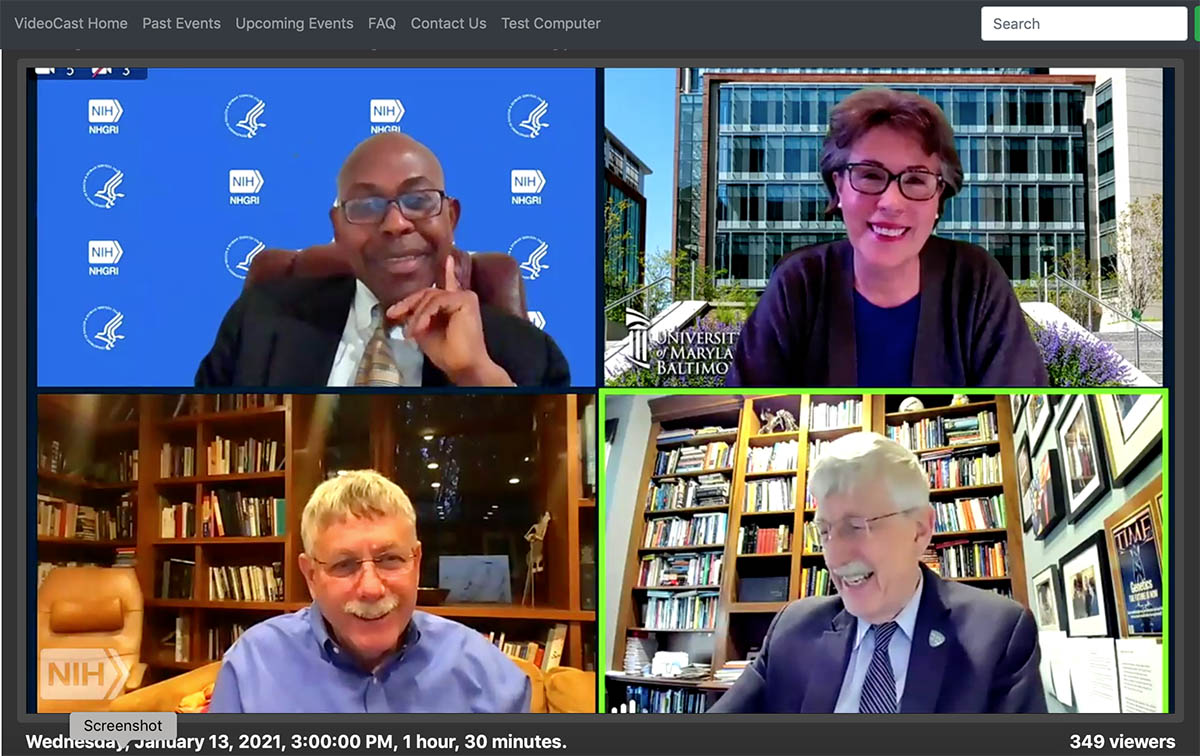Fueling the Next Genomic Revolution
WALS Panel Discussion Highlights Achievements in Genomics

CREDIT: NIH
Four genomics experts participated in a panel discussion at a virtual session of the Wednesday Afternoon Lecture Series on January 13, 2021. Clockwise from top left: Charles Rotimi, Claire Fraser, Francis Collins, and Eric Lander.
NIH celebrated three special anniversaries at a Wednesday Afternoon Lecture Series (WALS) special event on January 13, 2021: the 25th-year anniversary of the first complete bacterial genome; the 20th anniversary of the publication of the human genome; and the 15th anniversary of the first human metagenome (of microbial communities). NIH Director Francis Collins led a lecture and panel discussion featuring Claire Fraser, NIH alum and director of the Institute for Genome Sciences at the University of Maryland (Baltimore); Charles Rotimi, chief of the Metabolic, Cardiovascular, and Inflammatory Disease Genomics Branch at the National Human Genome Research Institute (NHGRI); and Eric Lander, president and founding director of the Broad Institute (Cambridge, Massachusetts) of MIT and Harvard.
Moreover, the WALS event marked one year since NIH scientists at the National Institute of Allergy and Infectious Diseases’ Vaccine Research Center began working with Moderna to create a COVID-19 vaccine, just three days after Chinese scientists published the genome of SARS-CoV-2, which causes COVID-19. That vaccine has since received FDA Emergency Use Authorization and is being used to immunize millions of people. The ability to achieve this feat so rapidly can be directly attributed to advancements made in genomics over the past two decades.
Collins himself is an important figure in the genome arena. He served as director of NHGRI (1993–2008), made landmark discoveries of disease genes, and led the international Human Genome Project, which aimed to sequence and map all the genes in humans. A working draft, covering more than 80% of the human genome, was published in 2001 in Nature, and the entire project was completed in 2003, two years ahead of schedule.
Putting the past in perspective
Fraser, who worked at NIH from 1985 to 1992, put the past in perspective with her talk entitled “Pathogens, Microbiome, and Host: Microbiology in the Genomics Era.” In 1995, she uncovered the first complete genome of a free-living organism, Haemophilus influenzae (a bacterium that causes lower respiratory tract infections), using whole-genome shotgun sequencing (a method for sequencing random DNA fragments, then using a computer to assemble them into chromosomes). Her work paved the way for a myriad of other projects. From reverse vaccinology, which uses a genomic sequence to identify vaccine candidates, to a genomic catalog of the Earth’s microbiomes, which has expanded known phylogenetic diversity of bacteria and archaea by 44%, almost no field has been left untouched. The future applications are seemingly boundless. “We’re in the infancy of microbiome-based diagnostics and therapeutics,” pronounced Fraser.
The ubiquity of genomic sequencing has led to a reexamination of the concept of a genome altogether, with the result being the development of the pan-genome concept. Fraser explained that the pan-genome includes all the genes in all the strains of a species. There was found to be such extensive diversity that the strain-specific genes may even outnumber the size of the core genome. “It became clear it would never be possible to describe a particular species with a single genome sequence,” said Fraser.
The history of humanity
Rotimi, who came to NIH in 2008 to establish the trans-NIH Center for Research on Genomics and Global Health, investigates the etiology of complex diseases and health disparities, and interethnic differences in the distribution of genetic and environmental risk factors.
His talk, “Genomes of African Ancestry Populations,” highlighted the necessity of sequencing the genomes of Africans, whose genomes have more variability and carry more diversity than other genomes. Rotimi pointed out that Africa is the ancestral home of all humanity and the place of 99% of human evolutionary history. This greater genetic variation provides more power to detect the relationship of genes to phenotypes.
Rotimi also emphasized the importance of studying African genomes as a social justice issue. “If we do not change course and include more African genomes, will tomorrow’s medicine work for everybody?” By leaving out African genomes, health and economic inequities will only be exacerbated, he added.
Future of genetics
Lander, who is now serving as the White House Science Advisor to President Joseph Biden, focused on the future of genetics in his talk “Common Disease Genetics: From Maps to Mechanisms to Medicine.” He explained that the first “phase” of human genetics research, spanning from 1980 to 2015, involved mapping disease genes. However, it takes too long to identify individual genes that play a role in a disease. “My sense is there’s more future than past,” said Lander, referring to human genetics research.
Lander also talked about a future in which integrating human genome data and microbiome data becomes commonplace. “I would love to see longitudinal microbiome data collected from all the participants in the ‘All of Us’ project,” NIH’s research program to collect genetic and health data from one million volunteers in an effort to accelerate medical breakthroughs. By integrating human genome and microbiome data, “we can fully understand the genetic basis of common disease and go easily from maps to mechanisms to medicine.”
As we enter the new phase of human genetics research—fueled by the establishment of large-scale human cohorts, the falling cost of genetic sequencing, and the rise of cloud-based data platforms—scientists aim to more efficiently determine disease mechanisms from human samples. Furthermore, the publication of datasets online allows for analysis by scientists all over the world.
To watch a videocast of the panel discussion, which took place on January 13, 2021, go to https://videocast.nih.gov/watch=40165.

Natalie Hagen is a postbaccalaureate research fellow in the National Center for Advancing Translational Sciences, where she is performing pharmacokinetics studies of novel drug candidates. After her fellowship is over in 2021, she is planning to pursue a Ph.D. In her spare time, she likes to run, read, and go hiking with friends.
This page was last updated on Tuesday, February 15, 2022
